Today’s batch of photos (we have more!) comes from reader Leo Glenn of western Pennsylvania, who also pays tribute to another contributor. Leo’s text and IDs are indented, and you can enlarge his photos by clicking on them. Note the felid lagniappe at the bottom.
It’s been a while since I contributed wildlife photos. I’m no Mark Sturtevant, but here are a few photos of insects I’ve taken this year, mostly on the daily dog walks.
Bald-faced hornet (Dolichovespula maculata) on goldenrod (Solidago sp.). Not a true hornet, which are in the genus Vespa, bald-faced hornets are a species of yellowjacket wasps. According to Wikipedia, they produce colonies of 400-700 workers, which is the largest colony size in its genus. They construct large paper nests, which they aggressively defend, a fact to which I can personally, and regrettably, attest:
Imperial moth caterpillar (Eacles imperialis), in its fifth and final instar, undoubtedly look for a place to pupate. They are polyphagous, feeding on many tree species, including pine, maple, oak, sassafras and sweetgum:
Another imperial moth caterpillar (Eacles imperialis) in its fifth instar, showing their color variability:
The aptly named pale beauty moth (Campaea perlata). They are in the family Geometridae, derived from Ancient Greek and meaning to measure the earth, as their larvae, also called inchworms, appear to be measuring as they perambulate along:
Splendid earth boring beetle (Geotrupes spendidus) And splendid it is. They are named earth boring because they make burrows to lay their eggs. They prefer fungi, but will also feed on dung, carrion, and feathers:
Spotted cuckoo spider wasp (Ceropales maculata) on Queen Anne’s lace (Daucus carota). Members of the spider wasp family (Pompilidae) are nearly all solitary. They are so named because the female captures and paralyzes spiders, transports them to its underground lair, and lays an egg in the abdomen of the spider. The hatched larva then consumes the spider from the inside. The spotted cuckoo spider wasp, as its name implies, does things a little differently. The female seeks out a female from another spider wasp species which already has a spider, follows her, and when she drops the spider momentarily to prepare her lair, the spotted cuckoo spider wasp dips in, lays her egg in the spider, and flies off. The unsuspecting spider wasp then places the spider in her lair and lays her own egg. But the spotted cuckoo wasp spider egg has evolved to hatch first and eat the other egg, before moving on to consume the spider.
Zabulon skipper butterfly (Lon zabulon), sipping nectar from a red clover flower (Trifolium pratense). Its proboscis is considerably longer than its body:
Giant leopard moth (Hypercompe scribonia). I had to move it to my palm to get a decent photo:
Common eastern bumble bee (Bombus impatiens) on mint flower (Mentha sp.):
Viceroy butterfly (Limenitis archippus). It was long thought to be an example of Batesian mimicry due to its strong resemblance to the monarch butterfly (It can be distinguished from the monarch by the black lines transversing its hind wings.). However, after it was discovered to also be distasteful to predators, it is now considered an example of Müllerian mimicry, which, to quote Wikipedia, is when “two or more well-defended species, often foul tasting and sharing common predators, have come to mimic each other’s honest warning signals, to their mutual benefit.”
One of my personal favorites, a lovely dogbane beetle (Chrysochus auratus) on its host plant, dogbane (Apocynum cannabinum). You can see my reflection, and my dog’s reflection, in its elytra.
Felid lagniappe: And finally, a few photos of our neighbor’s orange tabby, whose name is Moses. Moses likes to sit perfectly still in our driveway for long periods of time and stare at our house. My family call him the spy cat. He also likes to come up to the sliding door on our back deck and harass our cats (which are strictly indoor cats), causing them to hurl themselves into the glass with a resounding bong, He seems to prefer to do this in the predawn hours when the humans are still asleep. The first time it happened, I thought someone was breaking in.(Now we just yell, “Moses!” and try to go back to sleep.) My repeated attempts to befriend him failed, until recently, when persistence paid off, and I was finally able to get him to come to me. The photos capture that first successful encounter. Now we’re best buds, of course.



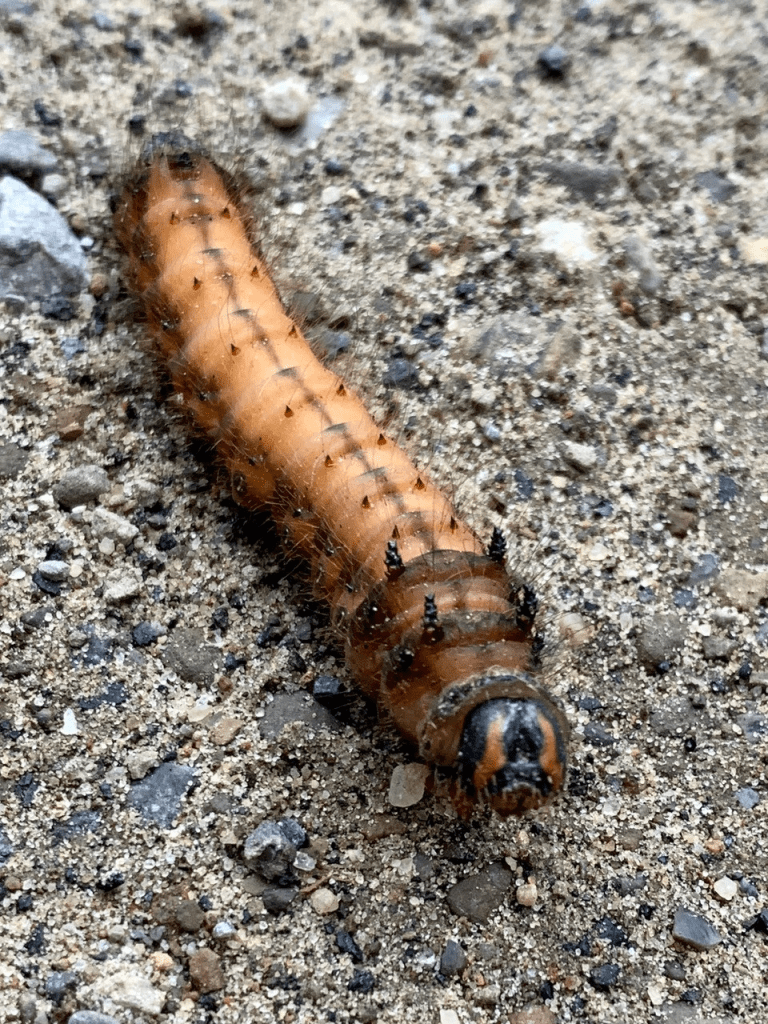


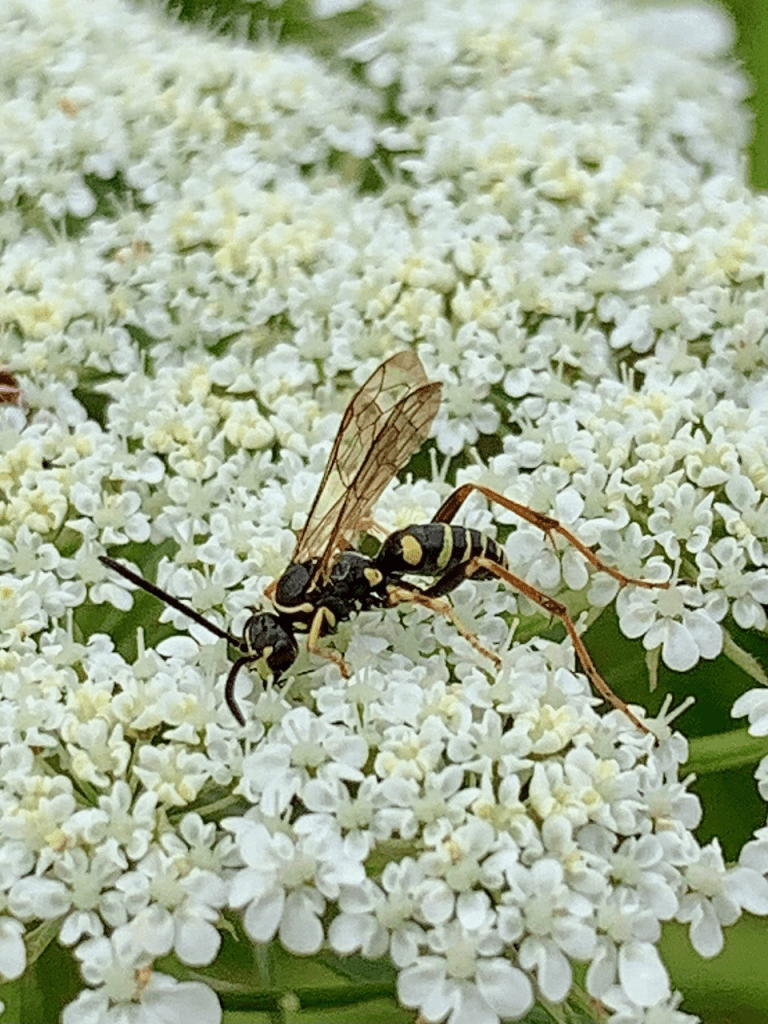
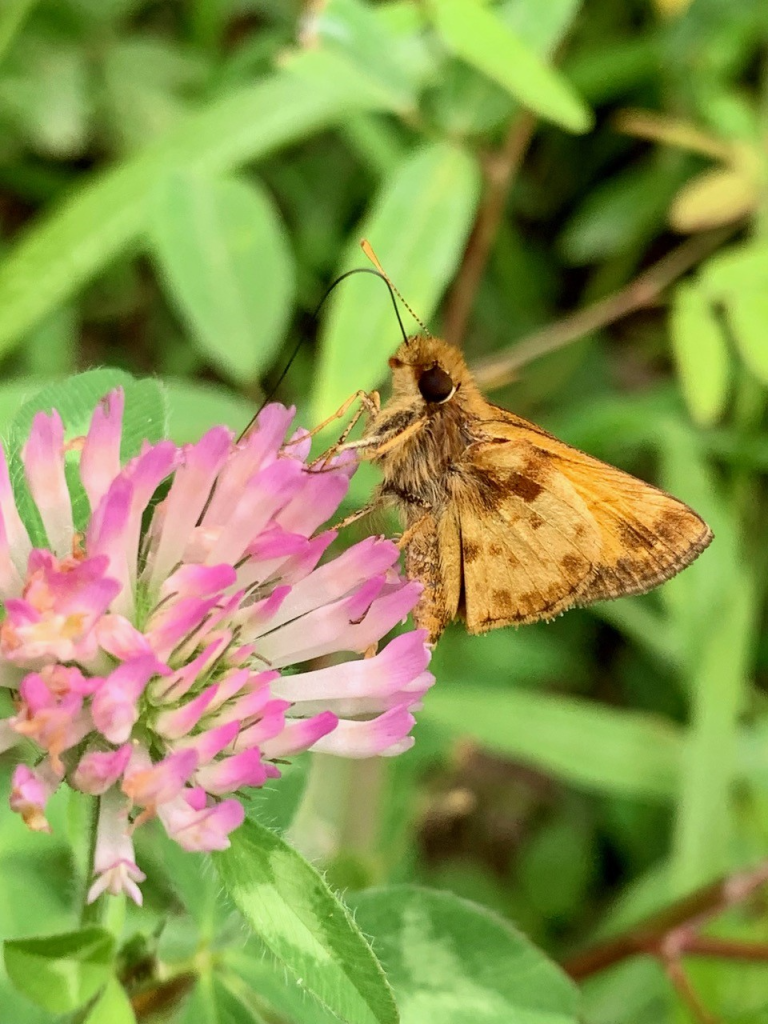


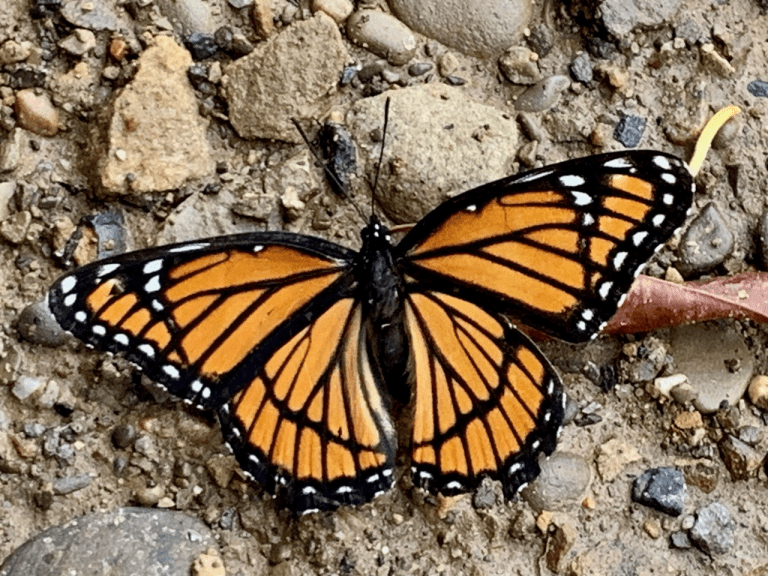
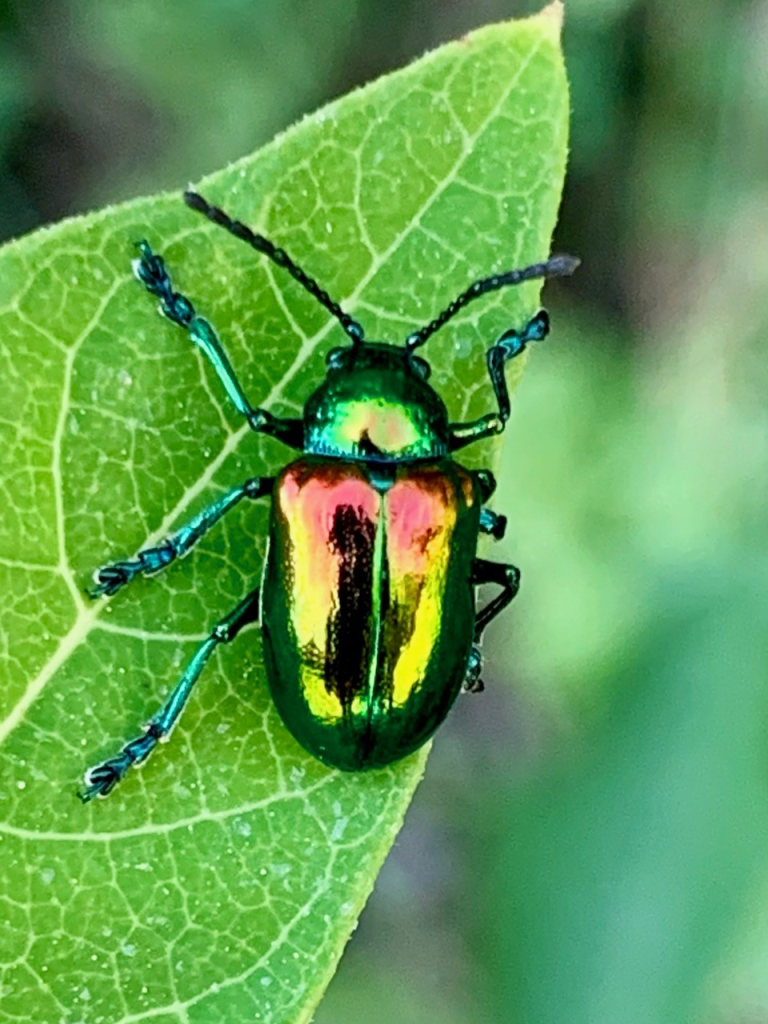
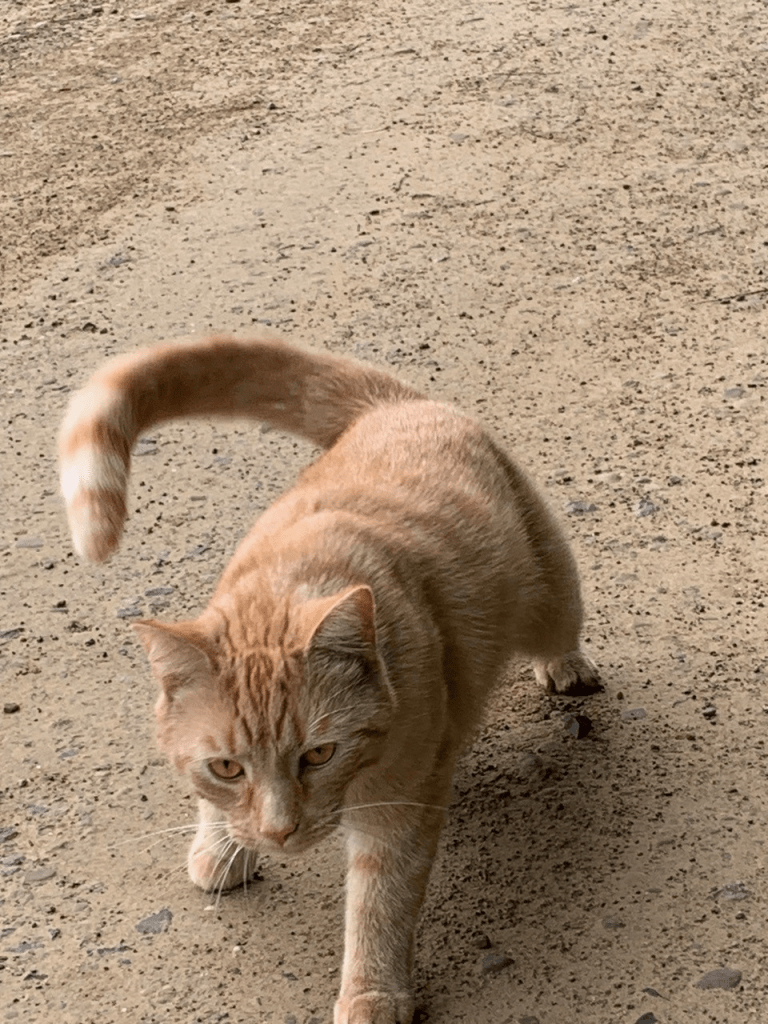


Mr. Sturtevant has some serious competition! (This is high praise, in case that meaning was lost).
I love that name Zabulon — don’t ask why!
I love the name Zabulon, too. If we ever get another cat (we currently have three), Zabulon will definitely be on the list of prospective names.
Superb photos! And Moses reminds me of our erstwhile next-door neighbor cat, Bill (The Cat), who was friends with our cat Wally (Cleaver).
Great shots. Thank you.
Wonderful, thank you!
Well polished, that beetle.
The plant name is … sort of low on the ambiguity scale. Given (Wiki) that it’s sap can also apparently raise blisters on hoomins, it’s also surprising that “[t]he seeds have an edible use as a meal (raw or cooked) when ground into a powder. […] The plant’s latex sap can be squeezed from the plant and allowed to stand overnight to harden into a white gum which can be used (sometimes mixed with clean clay) as chewing gum.” Inferring oxidation of some (not all?) components of the sap on standing, the other ingredients might make for a real “taste sensation”. Then again, “The milky sap is a folk remedy for genital warts.” How did it get that reputation?
I’d be careful of this on “brownfield” sites : “Apocynum cannabinum can be used to sequester lead in its biomass by taking it up from the soil through its roots. This process, called phytoremediation, could help clean sites contaminated with lead.” Unfortunately, the source doesn’t give an indication of how much it accumulates lead. But that’s just me wondering how contaminated the soil in my back yard is. I know it was an industrial site 150 years ago.
It’s a fascinating plant, for sure. The referential species name is due, I believe, to the plant’s structural similarities to Cannabis sativa, as opposed to its psychoactive properties. Other common names for it are hemp dogbane or Indian hemp, due to its surprisingly strong fibers, which, like hemp, can be made into cordage. The previous year’s stalks are used, which are dry and free of the caustic sap. I’ve never tried the seeds or the chewing gum, but I’ve made cordage from it many times. I’d put it up against any natural rope fiber. Even a quite thin strand of dogbane cordage is strong enough, if made properly, to lift an average person without breaking.
Yeah, I was thinking about the “cannab-” word-element too. Clearly something to do with a fibrous stem.
There’s a faint, distant memory bell working there, but I can’t quite get a hold on it. Memory equivalent of an “ear-worm”.
I can’t place that word-element in any mineral names. But it’s rattling inside my skull, trying to latch onto something and pull it to rapid-access memory.
The variety of moths amaze me. Everytime I see a new one, I am delighted. The Giant leopard moth is stunning. Glad you gave it the neutral background of your hand.
And the pale beauty moth— I’m sure it’s an illusion, but the wing edges look beveled.
The wings feather out at the edges, so they do appear beveled.
These are great, thanks! And not just the photos, the low-down on the spider wasps was fascinating. I’m here to both be entertained and educated, and you satisfied both objectives.
That was totally awesome! And I think your pictures are great.
And I’ve learned quite a lot. the Geotrupes beetle might be the genus of a mystery scarab that I’ve been puzzling over, for one thing, and iv’e never heard of cuckoo spider wasps. But it makes sense that there are such things as there are many kleptoparasites among the insects. Looking forward to more!
Thank you, Mark. Your photos are always an inspiration to me.
Baldface Hornets are very scary indeed. Give them a wide berth. Love the Giant Leopard Moth and, of course, the kitty cat!
Loved the shot of the hornet.
I too have a neighbouring ginger tom, who taunts my small indoor cat by sitting on the wall and staring. She hurls herself against the double glazing, puffed up and snarling. He sits there, clearly thinking “I could take you, with all four paws behind my back.” I don’t think this is a ginger cat thing, just the natural result of a large cat spotting a small cat. And it obviously gives him pleasure, as he visits so often.
Great closeup photos! Thanks!
What a wonderful post! Great photos and information.
Thanks!
Thank you, everyone, for your kind words.
Great photos, Leo. That giant Leopard moth is a beaut. Glad you befriended Moses, he is a looker.